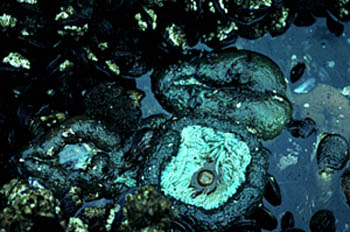Sea Anenomes
Identification
Anthopleura
elegantissima - Aggregating Sea Anenome
-
Aggregating, colonial
-
Have green to white tentacles that
are tipped with pink
-
The green color is due to the presence
of green pigemnt found in symbiotic green algae living in the tissues of
the anenome.
-
It can reach up to 7-8 cm in diameter
if it is solarity but in colonies they are about 1-2 cm in diameter.

Picture of aggregation of A. elegantissima attached to rock and covered
in bits of shells.
-
Irregularities in the arrangement of
mesenteries due to fission
-
Found in upper-mid tide zone, common
in wave exposed habitats (like sides or rocks)
-
Longitudinal fission results in aggregation
of small polyps
-
Can be found in Pt. Dune, Palos Verdes
Peninsula, Little Corona, Laguna Beach, Dana Point, Marina
del Rey, Los Angeles to Long Beach Harbors, Alamitos Bay and Newport Bay.
Extends from west coast North America to Alaska and south to central Baja
California.

Picture by John Levinton (tentacles half tucked in)
Anthopleura xanthogrammica
- The Green Sea Anenome

-
Solitary
-
Deep green becuase of algae found in
tissues
-
Anenomes found in caves or rocks are
pale green.
-
Can be up to 15 cm in diamter and 30
cm tall
-
Found from Japan to southern California
(south of Pt. Conception)
-
Found in the middle low tide zone of
intertidal
-
Uniformly blue-green oral disc
-
No white stripes or markings on tentacles
-
Pedal disc spreads beyond the column
diameter and is rounder

Picture by John Levinton (tentacles tucked in)

Anthopleura
sola - The Sunburst Anenome

-
Solitary
-
No fission scars because it does not
divide and grows into isolated individuals
-
20-25 cm polyps (measured across tentacle
crown)
-
Pigmented mesenterial insertions or radial sun like oral
disc patterns
-
Intertidal or subtidal, in protected rock crevices or pools
-
In subtidal, the oral disk is covered with sand, or partially
buried in sand
-
Range from north eastern Mexico to North of San Francisco
Bay
-
Pedal disk is about the same size as the column, thicker
and is an irregular circle


Picture of A. sola during under water and half
covered in water.
* It is not possible to distinguish A. elegantissima
from A. sola when both are small and A. elegantissima has
not yet divided scars are not visible.






